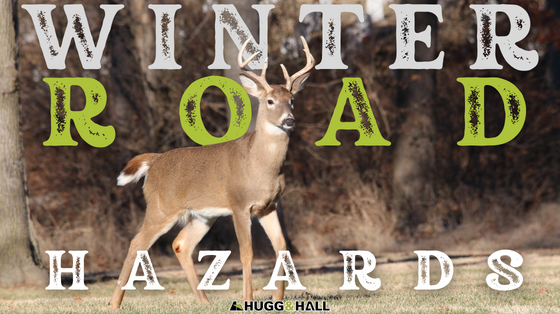
Winter Road Hazards
As the weather cools off, winter road hazards arrive. Cooler, damper weather and shorter days encourage wildlife to travel across roadways, and wet roads can freeze. Our HSE Safety Specialist provided us with this list of tips to lower your chances of getting into a car accident, and we want to share it with you!
Want more information? Download our complete guide to winter construction site prep!
Wildlife Safety Tips
- In winter, deer and other wildlife are more active in the early- to mid-morning hours and from late-afternoon through dusk.
- Hunting season can force wildlife out of their natural habitat towards roadways and populated areas. Always scan the roadways for deer.
- Slow down if you are traveling a route where deer are often present or deer crossing signs are posted.
- If an animal runs in front of your vehicle, brake and do not swerve. Attempting to miss the animal is more dangerous. Swerving can cause collisions with other drivers or cause you to drive into a ditch or tree.
Winter Weather Safety Tips
- If roadways are wet from rain, snow, sleet, ice, etc., you should increase your following distance from other cars. You should be approximately four car lengths from the car in front of you, double your standard following distance.
- The time change during Daylight Savings can result in driver fatigue. Plan accordingly and get plenty of rest.
- Your tire pressure will drop as the temperature does. Fill your tires to the manufacturer’s recommended pressure (located on the driver’s side door frame). It’s a good idea to inspect your tires at least once a month.
- Keep your gas tank close to full. If you have an electric vehicle, plug it in at night to keep the battery temperature within optimal ranges.
- If you need to break suddenly, you should be aware of whether or not you have antilock brakes. If you do, apply firm, continuous pressure to the brake pedal. If you don’t have antilock brakes, you may need to pump your brakes if your wheels start to lock up.
- Stock your vehicle in case of emergency. Kits can include water, nutritious snacks, blankets, a flashlight, an ice scraper/snow brush, and more.
Even if you do not drive a company vehicle, weather conditions and wildlife can affect you. Incorporating these tips into your daily drives can make for safer roadways!
Have additional questions? Contact us! Interested in learning more about keeping your team safe and your equipment in tip-top shape? Download our complete Winter Prep Guide!
Want more winter weather tips and tricks? Check out our resources section!
This article was originally published in December 2021. We updated it for freshness, accuracy, and comprehensiveness in January 2023.
Back to News
Subscribe and unlock cutting-edge equipment insights, trends and tips!
Subscribe
